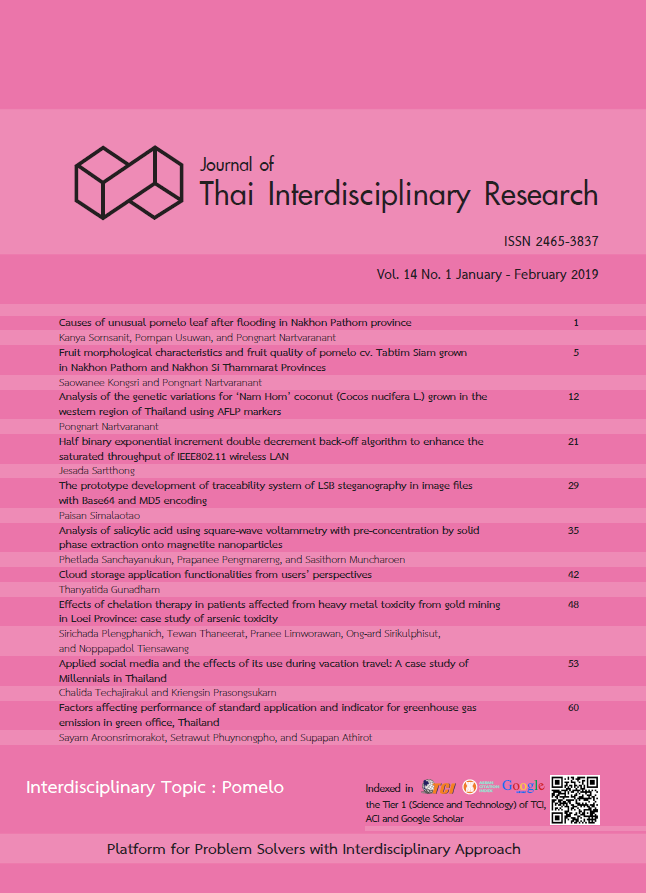The prototype development of traceability system of LSB steganography in image files with Base64 and MD5 encoding
Main Article Content
Abstract
The objective of this research is to study and develop the prototype of traceability system using LSB steganography in image files with Base64 and MD5 encoding. The research methodology follows SDLC process composed of problem investigation, system analysis and design, system development and system testing. Research tool is the prototype of traceability system using LSB steganography in image files with Base64 and MD5 encoding, developed from HTML5, JAVA and PHP scripts connecting to MySQL database on Apache Web Server. Files were converted to ASCII binary bits and encoded with Base64 and MD5 sequentially, then transformed to binary bits again to replace the last bit of each pixel which was converted from the original image file bit by bit.
From the result of the experiment on the image files which have different resolution (72 pixel/inch), the file size of converted image files were not different from the original image files. When unhidden and decoding, the complete original files were discovered and traceable. It can be concluded that the prototype of traceability system using LSB steganography in image files with Base64 and MD5 encoding is efficient in terms of processing time and non-different file size from original.
Article Details
References
Xijina W, Linxiub F. The application research of MD5 encryption algorithm in DCT digital watermarking, Physics Procedia. 2012; 25: 1264–1269.
Cheddad A et al. Digital image steganography: survey and analysis of current methods. Elsevier B.V. Signal Processing. 2010; 90(3): 727-752.
Sharma et al. A study of steganography based data hiding techniques. International Journal of Emerging Research in Management & Techno-logy. 2017; 6(4): 145–150.
Ibrahim R, Kuan TS. Steganography algorithm to hide secret message inside an image. Computer Technology and Application 2. 2011; 102-108.
Nath J, Nath A. Advanced steganography algorithm using encrypted secret message. International Journal of Advanced Computer Science and Applications. 2011; 2(3):19-24.
Rivest R. The MD4 message digest algorithm. Proceedings of the 10th Annual International Cryptology Conference on Advances in Cryptology. 1990; 303-311.
Den Boer B, Bosselaers A. An attack on the last two rounds of MD4. Adv Cryptol –CRYPTO 199; [cited 13 April 2018]. Available from: http:// www.springerlink.com/index/4yb85bkpxt5gemmh.pdf
Dobbertin H. Cryptanalysis of MD4. Journal of Cryptology. 1998; 11: 253-271.
Den Boer B, Bosselaers A. Collisions for the compression function of MD5. advances in cryptology. EUROCRYPT ’93. Lecture Notes in Computer Science. 1994; 765: 293–304.
Thomas CG, Jose RT. A comparative study on different hashing algorithms. International Journal of Innovative Research in Computer and Communication Engineering. 2015; 3(7):170–5.
Sumartono I, Siahaan APU, Arpan A. Base64 character encoding and decoding modeling. International Journal of Recent Trends in Engineering & Research. 2016; 2(12):63-68.
AlAhmad, M. A., A. Shaikhli, et al. Protection of the texts using base64 and MD5. Journal of Advanced Computer Science and Technology Research 2. 2012; 22-34.
Chitradevi B, Thinaharan N, Vasanthi M. Data hiding using least significant bit steganography in digital images. Statistical Approaches on Multidisciplinary Research. 2017; 143-150.
Pakdeetrakulwong U, Hengpraprohm K. An ontology-based knowledge management for organic and good agricultural practice agriculture: A case study of Nakhon Pathom Province, Thailand. Journal of Thai Inter disciplinary Research. 2018; 13(4): 26-34.
Sirisukpoca U, Simalaotao P. Increase student achievement of students in third grade by teaching media with the application of local wisdom on geographical maps and the content offered through augmented reality. Journal of Thai Interdisciplinary Research. 2016; 11(3):24-31

